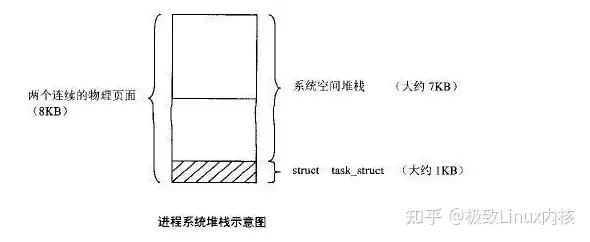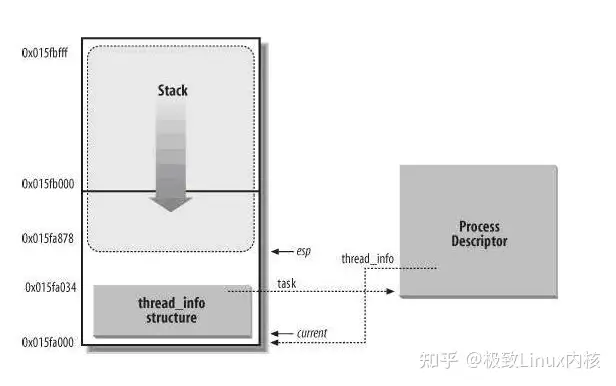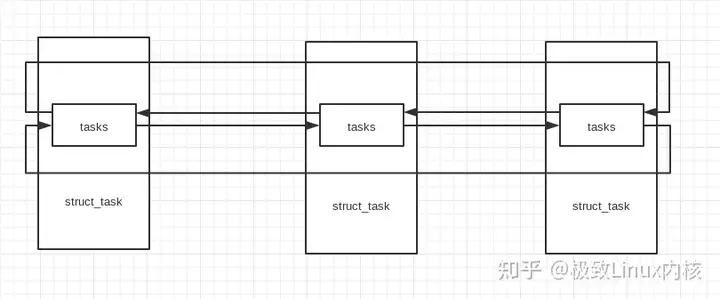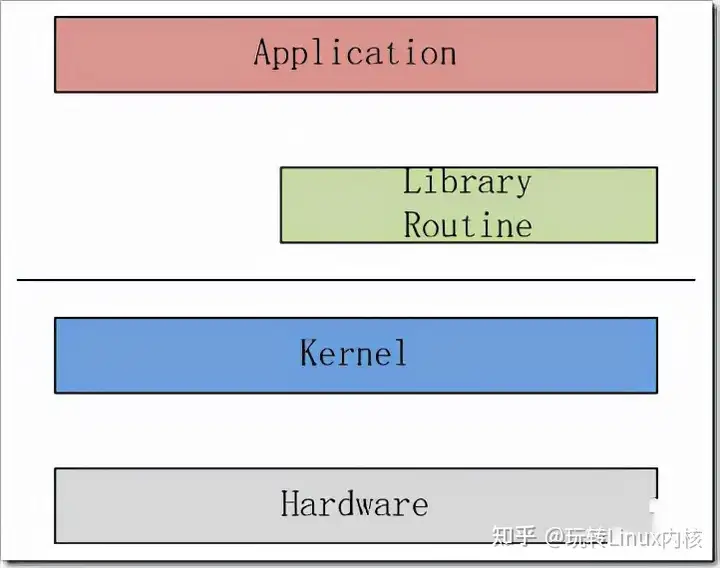内核为每个进程分配一个task_struct结构时,实际上分配两个连续的物理页面(8192字节),如图所示。底部用作task_struct结构(大小约为1K字节),结构的上面用作内核堆栈(大小约为7K字节)。访问进程自身的task_struct结构,使用宏操作current, 在2.4中定义如下:
根据内核的配置,THREAD_SIZE既可以是4K字节(1个页面)也可以是8K字节(2个页面)。thread_info是52个字节长。
下面是thread_info结构体的定义:
1 2 3 4 5 6 7 8 9 10 11 12 13 14 15 16 17 18 19 struct thread_info { struct task_struct *task; /* main task structure */ struct exec_domain *exec_domain; /* execution domain */ __u32 flags; /* low level flags */ __u32 status; /* thread synchronous flags */ __u32 cpu; /* current CPU */ int preempt_count; /* 0 => preemptable, <0 => BUG */ mm_segment_t addr_limit; struct restart_block restart_block; void __user *sysenter_return; #ifdef CONFIG_X86_32 unsigned long previous_esp; /* ESP of the previous stack in case of nested (IRQ) stacks */ __u8 supervisor_stack[0]; #endif unsigned int sig_on_uaccess_error:1; unsigned int uaccess_err:1; /* uaccess failed */ };
可以看到在thread_info中个task_struct结构体,里面包含的是进程描述符,其他的参数如下:(可以略过)
(1) unsigned short used_math;
是否使用FPU。
(2) char comm[16];
进程正在运行的可执行文件的文件名。
(3) struct rlimit rlim[RLIM_NLIMITS];
结 构rlimit用于资源管理,定义在linux/include/linux/resource.h中,成员共有两项:rlim_cur是资源的当前最大 数目;rlim_max是资源可有的最大数目。在i386环境中,受控资源共有RLIM_NLIMITS项,即10项,定义在 linux/include/asm/resource.h中,见下表:
(4) int errno;
最后一次出错的系统调用的错误号,0表示无错误。系统调用返回时,全程量也拥有该错误号。
(5) long debugreg[8];
保存INTEL CPU调试寄存器的值,在ptrace系统调用中使用。
(6) struct exec_domain *exec_domain;
Linux可以运行由80386平台其它UNIX操作系统生成的符合iBCS2标准的程序。关于此类程序与Linux程序差异的消息就由 exec_domain结构保存。
(7) unsigned long personality;
Linux 可以运行由80386平台其它UNIX操作系统生成的符合iBCS2标准的程序。 Personality进一步描述进程执行的程序属于何种UNIX平台的“个性”信息。通常有PER_Linux、PER_Linux_32BIT、 PER_Linux_EM86、PER_SVR3、PER_SCOSVR3、PER_WYSEV386、PER_ISCR4、PER_BSD、 PER_XENIX和PER_MASK等,参见include/linux/personality.h。
(8) struct linux_binfmt *binfmt;
指向进程所属的全局执行文件格式结构,共有a。out、script、elf和java等四种。结构定义在include/linux /binfmts.h中(core_dump、load_shlib(fd)、load_binary、use_count)。
(9) int exit_code,exit_signal;
引起进程退出的返回代码exit_code,引起错误的信号名exit_signal。
(10) int dumpable:1;
布尔量,表示出错时是否可以进行memory dump。
(11) int did_exec:1;
按POSIX要求设计的布尔量,区分进程是正在执行老程序代码,还是在执行execve装入的新代码。
(12) int tty_old_pgrp;
进程显示终端所在的组标识。
(13) struct tty_struct *tty;
指向进程所在的显示终端的信息。如果进程不需要显示终端,如0号进程,则该指针为空。结构定义在include/linux/tty.h中。
(14) struct wait_queue *wait_chldexit;
在进程结束时,或发出系统调用wait4后,为了等待子进程的结束,而将自己(父进程)睡眠在该队列上。结构定义在include/linux /wait.h中。
13. 进程队列的全局变量
(1) current;
当前正在运行的进程的指针,在SMP中则指向CPU组中正被调度的CPU的当前进程:
#define current(0+current_set[smp_processor_id()])/sched.h /
struct task_struct *current_set[NR_CPUS];
(2) struct task_struct init_task;
即0号进程的PCB,是进程的“根”,始终保持初值INIT_TASK。
(3) struct task_struct *task[NR_TASKS];
进程队列数组,规定系统可同时运行的最大进程数(见kernel/sched.c)。NR_TASKS定义在include/linux/tasks.h 中,值为512。每个进程占一个数组元素(元素的下标不一定就是进程的pid),task[0]必须指向init_task(0号进程)。可以通过 task[]数组遍历所有进程的PCB。但Linux也提供一个宏定义for_each_task()(见 include/linux/sched.h),它通过next_task遍历所有进程的PCB:
#define for_each_task(p) \
for(p=&init_task;(p=p->next_task)!=&init_task;)
(4) unsigned long volatile jiffies;
Linux的基准时间(见kernal/sched.c)。系统初始化时清0,以后每隔10ms由时钟中断服务程序do_timer()增1。
(5) int need_resched;
重新调度标志位(见kernal/sched.c)。当需要Linux调度时置位。在系统调用返回前(或者其它情形下),判断该标志是否置位。置位的话,马上调用schedule进行CPU调度。
(6) unsigned long intr_count;
记 录中断服务程序的嵌套层数(见kernal/softirq.c)。正常运行时,intr_count为0。当处理硬件中断、执行任务队列中的任务或者执 行bottom half队列中的任务时,intr_count非0。这时,内核禁止某些操作,例如不允许重新调度。
接下来写一个模块,打印当前的进程名字:
1 2 3 4 5 6 7 8 9 10 11 12 13 14 15 16 17 18 19 20 21 22 23 24 25 26 27 28 29 30 31 32 #include <linux/init.h> #include <linux/thread_info.h> #include <linux/module.h> #include <linux/sched.h> MODULE_LICENSE("GPL"); MODULE_AUTHOR("binary_tree"); int test_init() { printk("hello binary_tree!\n"); int i=0; struct thread_info * info; struct task_struct * t; unsigned long addr =(unsigned long)&i;// unsigned long base = addr & ~ 0x1fff;//屏蔽低13位 8K info = (struct thread_info *)base;// t= info -> task; printk("it is name is %s\n",t-> comm);//打印出进程名字 return 0; } void test_exit() { printk("bye! bye ! binary_tree! \n"); } module_init(test_init); module_exit(test_exit);
在栈中,struct_task的存在方式如下:
可以看到在struct_task中有一个staks的结构体,就是一个循环双向链表,因此,我们可以模拟出一个PS命令:
(今天布置的习题)
1 2 3 4 5 6 7 8 9 10 11 12 13 14 15 16 17 18 19 20 21 22 23 24 25 26 27 28 29 30 31 32 33 34 35 36 37 38 39 40 41 42 43 44 45 #include <linux/init.h> #include <linux/thread_info.h> #include <linux/module.h> #include <linux/sched.h> MODULE_LICENSE("GPL"); MODULE_AUTHOR("bunfly"); int test_init() { int i = 0; struct task_struct *t; struct thread_info *info; unsigned long addr = (unsigned long)&i; unsigned long base = addr & ~0x1fff; info = (struct thread_info *)base; t = info->task; struct task_struct* flag = t; struct task_struct *next = container_of(t->tasks.next, struct task_struct, tasks); //首地址 子类的类型, 父类 //获得t下一个进程符next; printk("now comm is %s\n",t->comm); struct task_struct *nnext = container_of(next->tasks.next, struct task_struct, tasks); //获得next下一个进程nnext while(nnext != flag) { next=nnext; nnext=container_of(next->tasks.next, struct task_struct, tasks); printk("next comm is %s\n",next->comm); } //依次循环打印下一个进程 printk("nnext comm is %s\n",nnext->comm); return 0; } void test_exit() { printk("exit\n"); } module_init(test_init); module_exit(test_exit);
在代码中,用到一个函数:container_of(ptr,type,mem),其中三个参数可分别描述为:ptr, type,mem,分别代表:
ptr :父类在子类对象中的首地址;
type :子类的类型:
mem :父类的实体(成员):
其具体的功能就是求下面是对container_of函数的具体实现:(重点讲解的)
1 2 3 4 5 6 7 8 9 10 11 12 13 14 15 16 17 18 19 20 21 22 23 24 25 26 27 28 29 30 31 32 33 34 35 36 37 38 39 40 41 42 43 44 45 46 47 48 1 #include<stdio.h> 2 3 #define container_of(ptr,type,mem) (type*)((unsigned long )(ptr)-(unsigned long)(&((type*)0)->mem)); 4 struct person 5 { 6 int age; 7 struct person* next; 8 }; 9 10 struct man 11 { 12 int len; 13 int size; 14 char name; 15 struct person p; 16 }; 17 18 int main() 19 { 20 struct man haha; 21 22 haha.len=100; 23 haha.p.age=20; 24 struct man* head = &haha.p;//已知父类在子类中的首地址 //3 25 // struct man* tmp=malloc(1); 26 // int size = (unsigned long)(&tmp->p)-(unsigned long)(tmp); 27 //2 28 // struct man* tmp=0; 29 // int size = (unsigned long)(&tmp->p); 30 // struct man* m=(struct man*)( (unsigned long )(head)-size ); 31 //1 32 //struct man* tmp=0; 33 //int size = (unsigned long)(&tmp->p); 34 //struct man* m=(struct man*)( (unsigned long )(head)-size ); 35 36 // struct man* m=(struct man*)((unsigned long )(head)-(unsigned long)(&((struct man*)0)->p)); 37 struct man* m = container_of(head,struct man,p); 38 39 // printf("head addr is %p\n",&head); 40 // printf("m addr is %p\n",&m); 41 // printf("head of len is %d\n",head->len); 42 // printf("head of age is %d\n",(head->p.age) ); 43 44 printf("m of len is %d\n",m->len); 45 printf("m of age is %d\n",m->p.age); 46 47 } ~
版权声明:本文为知乎博主「极致Linux内核 」的原创文章,遵循CC 4.0 BY-SA版权协议,转载请附上原文出处链接及本声明。
原文链接:https://zhuanlan.zhihu.com/p/549156208








